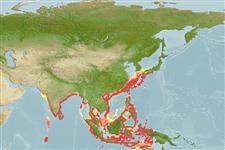Common names from other countries
Teleostei (teleosts) >
Eupercaria/misc (Various families in series Eupercaria) >
Nemipteridae (Threadfin breams, Whiptail breams)
Etymology: Parascolopsis: Greek, para in the side of + Greek, skolos = stake + Greek, ops = appearance (Ref. 45335).
More on authors: Temminck & Schlegel.
Environment: milieu / climate zone / depth range / distribution range
Ecology
Marine; demersal; non-migratory; depth range 60 - 131 m (Ref. 9785). Tropical; 36°N - 12°S, 69°E - 136°E (Ref. 3810)
Eastern Indian Ocean: including the Laccadive Islands, Sri Lanka, Andaman Sea. Western Pacific: including southern Japan and the South China Sea.
Size / Weight / Age
Maturity: Lm ? range ? - ? cm
Max length : 18.0 cm SL male/unsexed; (Ref. 3810); common length : 12.0 cm SL male/unsexed; (Ref. 3810)
Dorsal spines (total): 10; Dorsal soft rays (total): 9; Anal spines: 3; Anal soft rays: 7. Head scales reaching forward to between middle of eye. Posterior margin of preopercle sloping forward slightly. Lower limb of preopercle naked. Posterior margin of suborbital fine serrate, with a very small spine at upper corner. Pectoral fins long, reaching to or beyond level of anus. Pelvic fins long, reaching to or almost to level of anus. Color: Pale yellowish body, silvery below.
Inhabits sandy or muddy bottoms in offshore waters. Usually in small groups, in depths over 50 m (Ref. 48635). Feeds mainly on benthic invertebrates. Also caught with deep-sea shrimp traps.
Life cycle and mating behavior
Maturities | Reproduction | Spawnings | Egg(s) | Fecundities | Larvae
Russell, B.C., 1990. FAO Species Catalogue. Vol. 12. Nemipterid fishes of the world. (Threadfin breams, whiptail breams, monocle breams, dwarf monocle breams, and coral breams). Family Nemipteridae. An annotated and illustrated catalogue of nemipterid species known to date. FAO Fish. Synop. 125(12):149p. Rome: FAO. (Ref. 3810)
IUCN Red List Status (Ref. 130435)
CITES (Ref. 128078)
Not Evaluated
Threat to humans
Harmless
Human uses
Fisheries: minor commercial
Tools
Special reports
Download XML
Internet sources
Estimates based on models
Preferred temperature (Ref.
115969): 17.8 - 27.4, mean 24 (based on 251 cells).
Phylogenetic diversity index (Ref.
82804): PD
50 = 0.5002 [Uniqueness, from 0.5 = low to 2.0 = high].
Bayesian length-weight: a=0.01349 (0.00685 - 0.02655), b=2.96 (2.80 - 3.12), in cm Total Length, based on LWR estimates for this species & (Sub)family-body (Ref.
93245).
Trophic level (Ref.
69278): 3.5 ±0.44 se; based on food items.
Resilience (Ref.
120179): High, minimum population doubling time less than 15 months (K=0.70).
Fishing Vulnerability (Ref.
59153): Low vulnerability (21 of 100).
